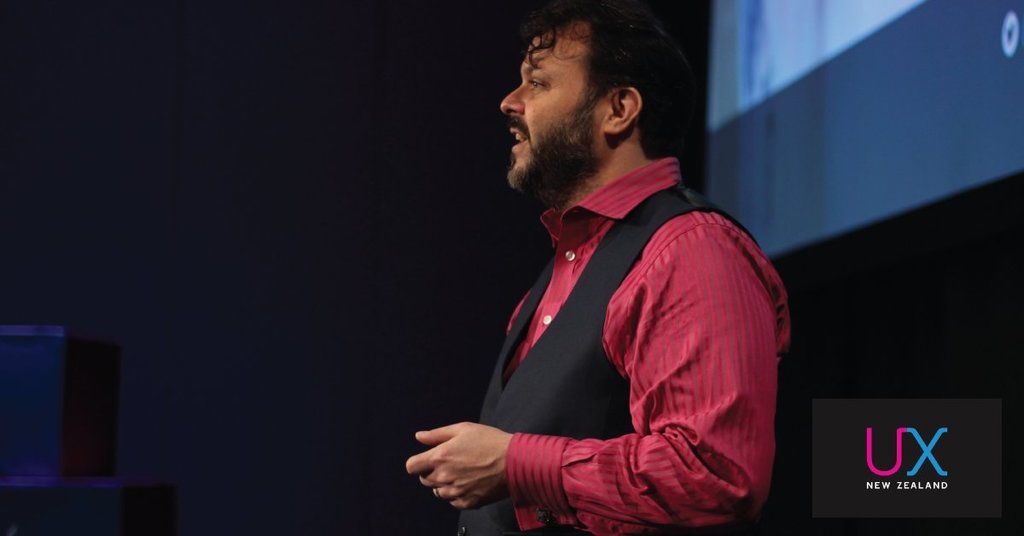At UX New Zealand Jason Cranford Teague shared some of his thinking on temporal design. Jason argued for an extension of UX practice and design thinking to consider the experience and evolution of designs in time.
This is a subject close to my heart. I’ve been talking about Trajectories, time and experience architecture for a few years now. So I thought I’d share my notes of Jason’s talk.
It was reassuring and a real pleasure to hear someone else talk about how telling stories and considering the temporal nature of all experience is vital to doing UX right.
Jason presented five elements of temporal design thinking (Context, narrative, agency, transition and adaptation).
I hope and think there are strong parallels to how I’ve recently been talking about Structure, Movement and Interaction as major principles in UX architecture.
The Structure created through well-practiced information architecture helps to establish shared Contexts between the actor-user and the system they’re encountering. Considering how we might establish and reinforce Context through Narrative seems to acknowledge the soft persuasion and coercion that good design rests on.
Although ‘actors’ have their own motivation, I think good IA persuades them to move towards a more shared perspective, closer to the designer’s intent. Structure gets a designer and an actor-user on the same page – sometimes literally. Structure establishes the “rules” of an experience [or rather the space the experience will occur in] – so structure helps to make sense.
My thinking about Movement probably contains ideas around affordance too – it acknowledges that while ‘actors’ are free to leave an experience, most of the time they will be moving through the space we have created. I like the idea of Transition in this.
In Jason’s talk there was a lovely strong thread of empowering the user – right from his rejection of that word and the adoption of ‘actor’. Perhaps well-designed structural affordances create the equivalent of ‘informed consent’ for the actor. They’re truly ‘acting’ when the movement has predictable outcomes – in the sense of they know what each action they take is likely to result in.
Finally I’ve been talking about Interaction. This seems slightly analogous to Jason’s Adaptation. I’ve been using the line:
The places I design are more like Hogwarts than Hampton Court.
I like the idea that the combination of dynamic structures and an actors’ movement mean that it’s a much more complicated task to understand and predict how someone will behave in your designed space.
While there are plenty of differences in our approach, and there’s loads of new inspiration I got from hearing Jason talk, I like to think that our ideas share lots too.
I think it’s the combination of spatial and temporal thinking that’s the biggest challenge we face.
I’m still not entirely sure we’ve got the words or the right visual language to represent this combination. I’m from the BBC and a geek – so I love Jason talking about ‘wibbly wobbly timey wimey stuff’.

But I also think that the perception of time is mainly linear. Each individual actor has a continuous experience from beginning to end – it’s just that the combination of space and time make things look really wibbly wobbly and non-linear to the external observer.
When an actor passes through a physical space – or even a narrative space like a book – they move predictably from A–B to eventually Z. The physics of those spaces imposes a linear constraint to how you can move through them.
But more interactive and ‘digital’ places empower the user to experience space differently. They’re empowered to move spaces around and aren’t forced by physics to experience B before they get to C.
I think that’s one of the challenges to considering the temporal in UX design – understanding the interplay of ‘space-time’ in digital places. I think that’s why I like my role as User experience architect so much – the architect covers the spatial aspects, while the ‘user experience’ tries to acknowledge and design for the temporal.
I was excited to see Jason end his talk where he began by talking about maps. I really do think representing that ‘space-time’ element in our designs is a big, unsolved problem… so it’s exciting to see where we take it next.

Leave a Reply